Bibimbap Korean Beef Bowls
A flavorful bibimbap recipe with the perfect amount of sweet and savory. This Korean beef recipe is quick, easy, and a crowd pleaser. Make Bibimbap Korean Beef Bowls on a night that you are looking for an easy solution that is different from your usual dinner menu.
This bibimbap recipe only takes minutes from start to finish and is a great dish for those nights when you want to eat a dish packed with flavor but not packed with tons of instructions and time. My Bibimbap Korean Beef Bowls are great because not only are they not labor intensive, the sweetness of the this Korean beef recipe makes it a pleasing dish for even the pickiest of pallets.
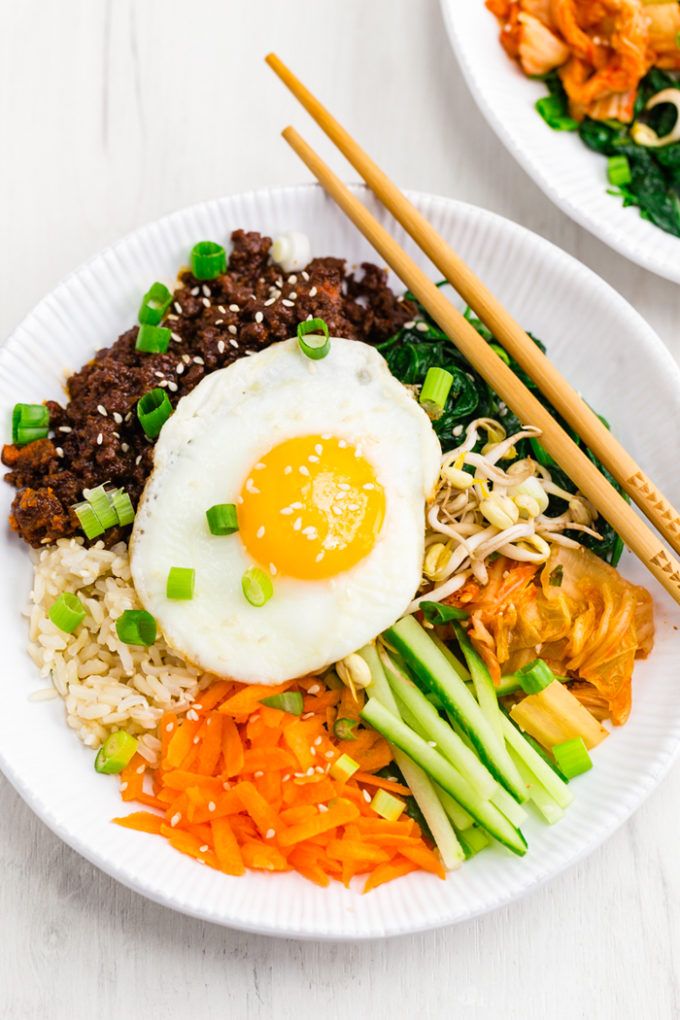 I am pretty sure I have never been more excited to share a recipe with you guys! I freaking love bibimbap! I had it for the first time in Wisconsin of all places. There is this super hipster trendy restaurant, and I checked it out, and the whole menu looked amazing, and I got to meet the chef, and he was awesome. So I just thought, why not try something I have never tried before. And so began my obsession. This is my version using a tasty Korean Beef, inspired by this Korean Beef Recipe I make in the Instant Pot.
I am pretty sure I have never been more excited to share a recipe with you guys! I freaking love bibimbap! I had it for the first time in Wisconsin of all places. There is this super hipster trendy restaurant, and I checked it out, and the whole menu looked amazing, and I got to meet the chef, and he was awesome. So I just thought, why not try something I have never tried before. And so began my obsession. This is my version using a tasty Korean Beef, inspired by this Korean Beef Recipe I make in the Instant Pot.
What is the Sauce in Bibimbap?
Bibimbap is growing in popularity and once you taste this dish you will quickly see why. However, I have to be upfront that this is not a totally traditional recipe. The common sauce used in Bibimbap Korean Beef Bowls is a Gochujang sauce, which
I don’t use in my Korean beef recipe. ( I will explain in a minute why I make my own sauce. )
What is a Gochujang sauce?
Gochujang sauce is basically a spicy sauce used in Korean cuisine. You can find it on Amazon. It is a red chili pepper paste.
Common Ingredients in Gochujang Sauce:
- Red chili pepper
- Fermented soy beans
- Glutinous rice powder
- Barley malt powder
- Salt
Why I Make My Own Sauce:
I love making authentic dishes, and love being able to help my kids experience new cultures and cuisines. But I also really like making food that appeals to a wide audience. So here are my top reasons for making my own sauce.
- Use of more universal flavors equaling a more kid friendly dish is my main reason for straying for the more traditional Bibimbap flavor profile to make my own sauce. My sauce focuses more on the sweet than the spicy. It has a little kick, and you can definitely amp it up if that is what you like, but I wanted to start with something everyone in my family would love, and customize from there.
- Ingredients in Gochujang sauce are more difficult to find. I have been lucky to find it on Amazon, you can check it out here: Gochujang Paste, and use it if you’d like. It is super tasty. But I don’t always have the forethought to order it before I want it. So this is easier I am using ingredients commonly found in my pantry!
- For some, Gochujang may be simply more fun to say than to eat. Don’t get me wrong, I realize the ingredients like fermented soy beans and glutinous rice powder have their place. However, if the people you are feeding don’t like spicy or haven’t grown-up with Gochujang, not everyone at the dinner table may appreciate this authentic Korean sauce, resulting in why I created a more Americanized version.
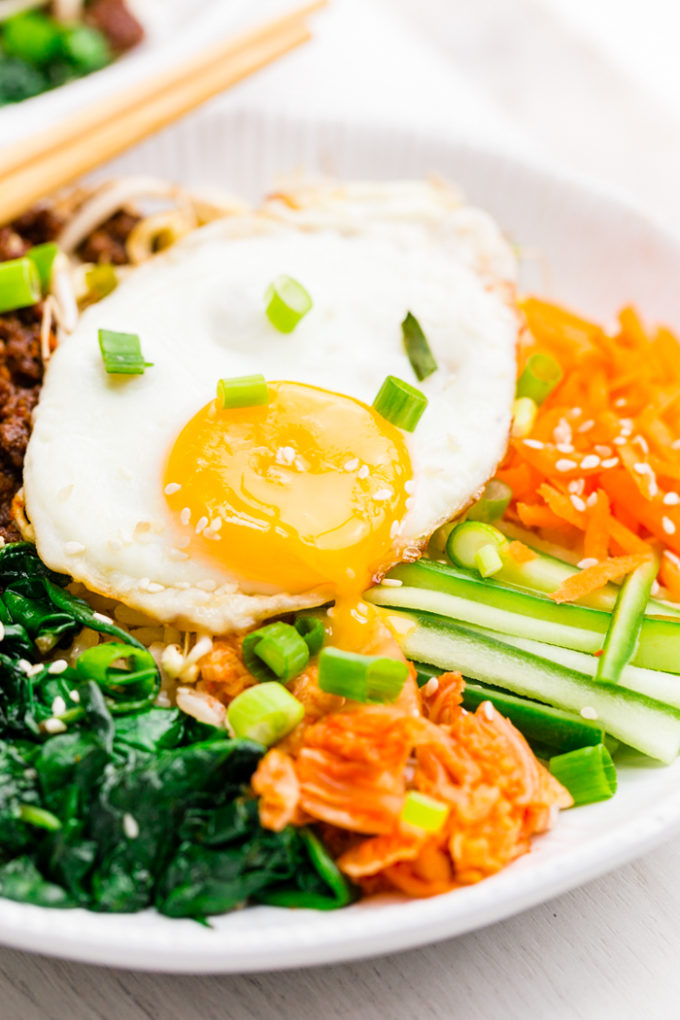
What Vegetables go in Bibimbap?
Bibimbap is a fun dish. Not only is it packed with flavor, there is a lot of color and nourishment on the plate. Any dish that has a variety of vegetables equals a dish that has a variety of benefits. And it makes it easy to customize for each family member.
Vegetables in Bibimbap:
- Cucumber
- Bean Sprouts
- Spinach
- Carrots
- Shitake Mushrooms
- Zucchini
- Kimchi- Yum!
*I don’t use mushrooms or zucchini in my recipe, but if either of these two ingredients make your heart happy, then of course listen to your heart and add either or both of these two vegetables to the recipe.
Tools Used When Cooking Bibimbap:
- Fortunately this dish can be cooked with minimal cooking tools. A large pan works great, and the meal can be served on a plate or in a bowl.
- However, if you want to really feel like you are having a Foreign food night experience, consider getting a dolsot. A dolsot is used in Korean cooking. It is large stone bowl that food can be cooked and eaten in, allowing food when presented to remain warmer longer, while letting rice continue to cook.
- For a dolsot check out Crazy Korean Cooking Korean Stone Bowl, which can be found on amazon.
Bibimbap Korean Beef Bowls are great for any night of the week. Serve over rice or noodles as a simple, complete meal or kick it up a notch and add Eazy Peazy Mealz Asian Chopped Salad as a side, followed by a light, citrusy dessert such as Eazy Peazy
Mealz Lemon Cheesecake Bars.
Simple, flavorful, and delicious! Bibimbap Korean Beef Bowls will become a repeat in your meal rotation.
*Note: Beef can be substituted with chicken or shrimp for a tasty chicken bibimbap or shrimp bibimbap option.
Other Favorite Recipes
- Huli Huli Chicken
- Spinach Dip
- Instant Pot Pork Chops
- Chicken Piccata
- Braised Short Ribs
- Baby Back Ribs
- Roasted Asparagus Oven Baked
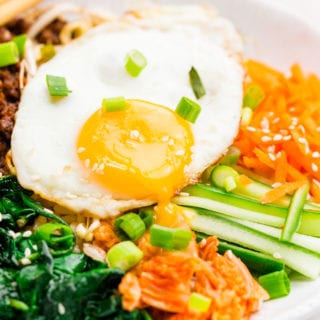
Bibimbap Korean Beef Bowls
Ingredients
Korean Beef
- 1 Lb ground beef
- 3 tsps minced garlic
- 1/2 cup water
- 1/2 cup soy sauce
- 1 Tbs chili flakes
- 1 Tbs chili powder
- 1 tsp paprika
- 3 Tbs sesame oil
- 4 Tbs brown sugar
- 3 tsps mirin or rice wine vinegar
Rice
- 4 cups cooked brown rice
Sauteed Spinach
- 1/2 Tbsp cooking oil
- 6 cups fresh spinach loosely packed
- 1 tsp sesame oil
- Pinch of salt
Toppings
- 1 carrot
- 1 cucumber
- 2 green onions
- 1/2 cup bean sprouts
- 4 large eggs
- 1/4 cup kimchi
- 1 Tbsp roasted sesame seeds
Instructions
- Start by preparing your bown rice. While it cooks, prepare other ingredients.
Sauteed Spinach
- Heat a large skillet over medium heat and add the cooking oil.
- Add the fresh spinach.
- Sauté the spinach for a few minutes, or just until it is wilted.
- Drizzle the sesame oil over top and season lightly with a pinch of salt.
- Remove the spinach from the skillet and set aside
Korean Beef
- Over medium-high heat, add olive oil to the bottom of the same large skillet, and add ground beef
- Brown the ground beef, add the minced garlic, and stir.
- Once browned, drain the ground beef, and add all sauce ingredients.
- Stir well. Once cooked, set aside.
Vegetables
- Prepare the fresh vegetables.
- Peel and grate the carrot, Thinly slice the cucumber, and slice the green onions.
- Fry or soft boil 6 large eggs
Assemble
- Assemble 4 bowls by adding 1 cup cooked rice to each bowl, 1/4 of the cooked spinach, 1/4 of the ground beef, sliced cucumber, bean sprouts, shredded carrots, a cooked egg, a tablespoon of kimchi. Sprinkle sliced green onions and sesame seeds over the top.
- Enjoy!
Nutrition
Our recipe card software calculates these nutrition facts based on averages for the above ingredients, different brands, and quality of produce/meats may have different nutritional information, always calculate your own based on the specific products you use in order to achieve accurate macros for this recipe.
Pin to your Dinner board on Pinterest:
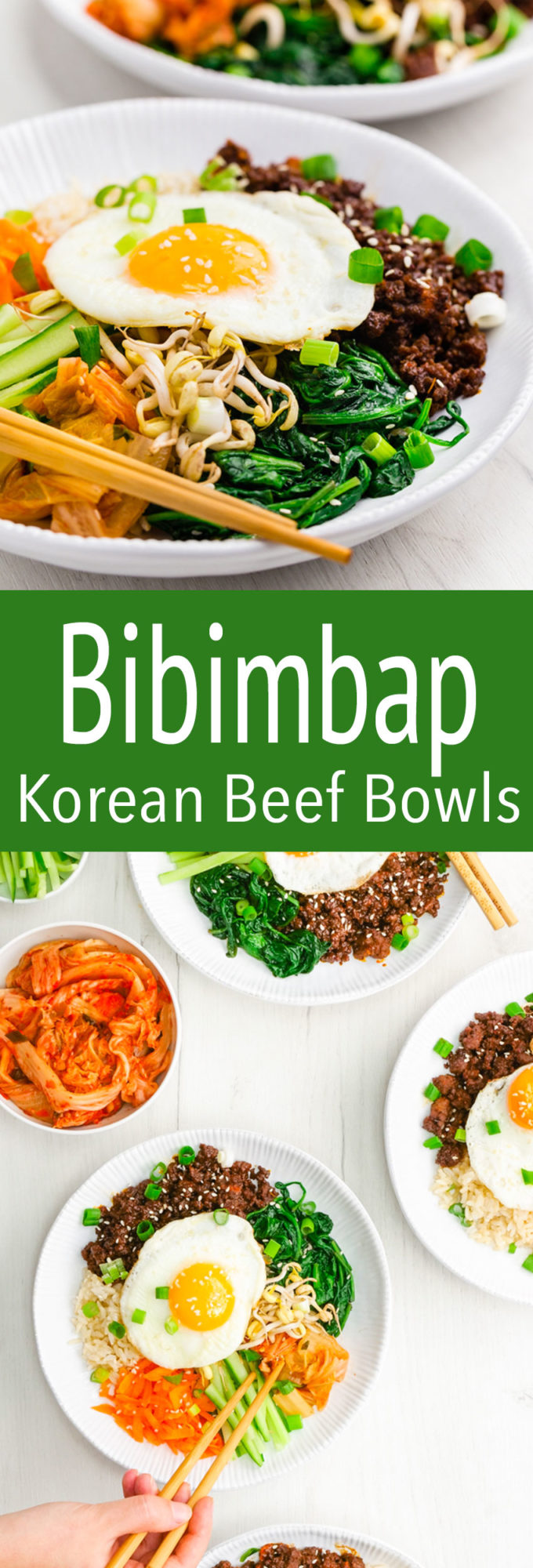

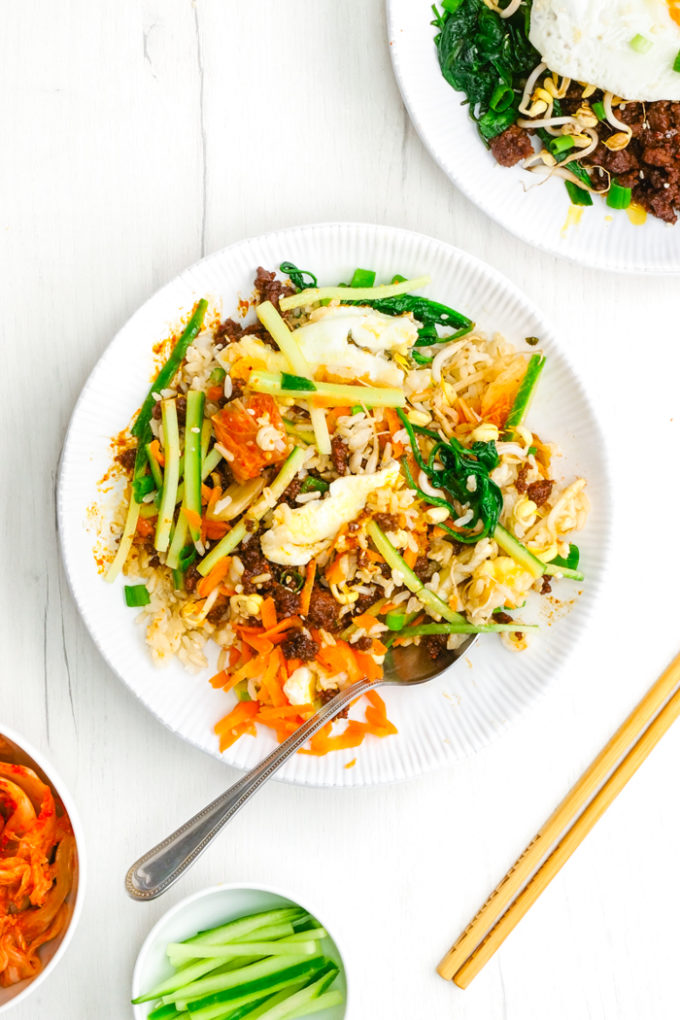

Cindy says